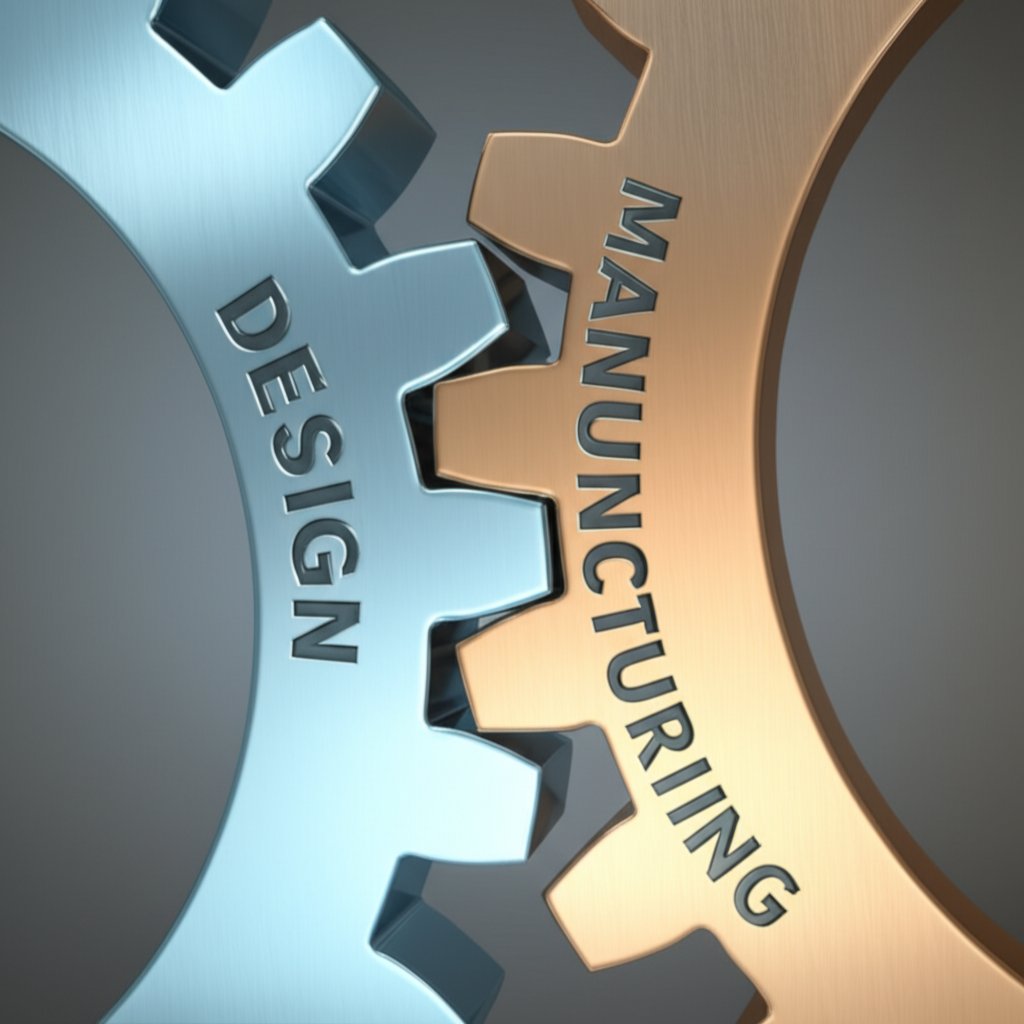Mastering Design for Manufacturability (DFM) for Quality

TL;DR
Design for Manufacturability (DFM) is an engineering practice focused on designing products for ease of manufacturing and reduced production costs. By integrating manufacturing considerations early in the design phase, DFM simplifies product structure, standardizes components, and optimizes materials. The primary goals are to improve quality, accelerate time-to-market, and minimize expenses by addressing potential production issues before they become costly problems.
What Is Design for Manufacturability (DFM)?
Design for Manufacturability, often abbreviated as DFM, is a proactive engineering methodology that embeds manufacturing insights directly into the product design process. Instead of creating a design and then figuring out how to build it, DFM requires designers and engineers to think about the production process from the very beginning. This approach aims to create a product that not only meets its functional and aesthetic requirements but can also be produced efficiently, reliably, and cost-effectively at scale. It represents a critical shift from a siloed approach—where design and manufacturing teams work separately—to a collaborative one.
The core principle of DFM is that a significant portion of a product's lifecycle cost is determined during its design phase. According to various industry analyses, an estimated 70% of manufacturing costs are locked in by design decisions related to materials, fabrication processes, and assembly methods. By addressing manufacturability upfront, companies can avoid expensive redesigns, tooling changes, and production delays that often arise when a design proves difficult or impossible to manufacture as specified. This early intervention is far more effective and less costly than making changes after tooling has been created and production has begun.
A simple yet effective example of DFM in action is the use of snap-fit components instead of screws. A designer might initially plan to join two plastic housing parts with several small screws, requiring additional components (the screws), labor time for insertion and tightening, and potential for assembly errors. A DFM approach would challenge this, suggesting an integrated snap-fit design. This change eliminates the need for fasteners, reduces the part count, simplifies the assembly process to a single action, and lowers both material and labor costs, all while achieving the same functional goal.
Ultimately, DFM is a strategic discipline that bridges the gap between design innovation and manufacturing reality. It forces a holistic view of product development, ensuring that choices made by the design team are validated against the capabilities and limitations of the production floor. This integration helps prevent common pitfalls like overly complex geometries that are difficult to machine, tolerances that are unnecessarily tight, or material selections that are incompatible with the chosen manufacturing process. The result is a smoother, faster, and more economical path from concept to market.

The Core Principles of DFM
Effective Design for Manufacturability is guided by a set of fundamental principles that help engineers and designers streamline production and reduce costs. These principles serve as a checklist to evaluate a design's readiness for efficient manufacturing. By systematically applying these concepts, teams can identify and eliminate unnecessary complexity and expense before a product ever reaches the factory floor.
-
Minimize Part Count
One of the most impactful principles of DFM is the reduction of the total number of individual parts in a product. Every part requires its own tooling, handling, processing, and assembly. By consolidating multiple components into a single, multi-functional part, companies can drastically cut down on material, assembly labor, and inventory management costs. For instance, designing a single molded plastic part with integrated brackets, clips, and supports is far more efficient than creating separate pieces that must be fastened together. -
Standardize Parts and Materials
Customization is a significant driver of cost and complexity. The principle of standardization encourages the use of off-the-shelf components and common materials whenever possible. Using standard fasteners like M3 screws instead of custom-made ones, or designing around common raw material sizes, simplifies sourcing, reduces inventory complexity, and leverages economies of scale. As detailed by East West Manufacturing, standardization ensures consistency and shortens production time because parts are readily available and their quality is predictable. -
Select the Right Manufacturing Process
The choice of manufacturing process—such as injection molding, CNC machining, or sheet metal stamping—has profound implications for cost, quality, and design limitations. DFM requires that the design is optimized for a specific, chosen process. For example, a part designed for injection molding should have features like consistent wall thickness and appropriate draft angles to prevent defects and ensure easy removal from the mold. Designing a part without considering the process can lead to infeasible designs or the need for a much more expensive manufacturing method. -
Design for Ease of Assembly
Often referred to as Design for Assembly (DFA), this principle focuses on making the product as simple to put together as possible. This includes designing parts that are symmetrical to avoid incorrect orientation, using features like chamfers and tapers to guide parts into place, and minimizing the need for fasteners by using snap-fits or tabs. An easily assembled product reduces labor costs, lowers the chance of errors, and increases production throughput. -
Specify Tolerances Wisely
Tolerances define the acceptable range of variation for a part's dimensions. While tight tolerances are sometimes necessary for critical functions, they are often over-specified, which significantly increases manufacturing costs. Machining a part to a very high precision requires more advanced equipment, longer cycle times, and higher scrap rates. A core DFM principle is to specify the loosest possible tolerances that still allow the product to function correctly. This reduces machining time and cost without sacrificing performance.
Key Benefits of Implementing DFM
Adopting a Design for Manufacturability strategy yields significant, tangible benefits that extend far beyond the factory floor. By proactively optimizing a design for production, organizations can enhance their competitive advantage through reduced costs, accelerated product launches, and superior quality. These advantages create a powerful business case for integrating DFM into every stage of the product development lifecycle.
The most immediate and quantifiable benefit of DFM is substantial cost reduction. Costs are lowered across multiple areas: fewer components reduce material and inventory expenses, simplified designs decrease assembly labor, and optimized processes minimize tooling and machining time. For example, by identifying and eliminating an almost impossible-to-manufacture undercut in a part design, aerospace company Rafael was able to reduce the part's cost by over 50% and attract more competitive bids from suppliers. These savings accumulate throughout the production run, leading to higher profit margins and a more competitively priced product.
Another critical advantage is a faster time-to-market. Traditional product development often involves a lengthy cycle of design, prototyping, testing, and then redesigning after manufacturing issues are discovered. DFM compresses this timeline by resolving production challenges during the initial design phase. This streamlined process minimizes the need for costly and time-consuming revisions, allowing companies to move from concept to full-scale production more quickly. This speed can be a decisive factor in fast-moving industries where capturing market share depends on being first.
Furthermore, DFM directly contributes to higher product quality and reliability. Designs that are simple and optimized for manufacturing naturally have fewer opportunities for error during production and assembly. By standardizing parts and processes, DFM ensures greater consistency from one unit to the next. Features designed to be robust and easy to fabricate are less likely to suffer from manufacturing defects that could lead to field failures, warranty claims, and damage to brand reputation. In essence, a product that is easy to build correctly is also more likely to be a high-quality product.

Implementing DFM: A Practical Framework
Successfully integrating Design for Manufacturability into a product development lifecycle is a strategic process, not a single event. It requires a shift in mindset, cross-functional collaboration, and the right tools to be effective. A practical framework for implementation ensures that manufacturability is considered consistently from the initial concept through to final production.
The first step is to establish a cross-functional team early in the design process. This team should include not only design engineers but also manufacturing engineers, quality assurance specialists, procurement experts, and even external suppliers. By bringing these diverse perspectives together from the outset, potential manufacturing constraints, material availability issues, and assembly challenges can be identified and addressed before they become embedded in the design. Regular review meetings allow this team to challenge design choices and collaboratively find the most efficient solutions.
Next, the team should leverage DFM analysis tools and checklists. Modern CAD software often includes DFM analysis modules that can automatically flag potential issues like inconsistent wall thicknesses, difficult-to-machine features, or lack of proper draft angles. Beyond automated tools, developing a company-specific DFM checklist based on available manufacturing capabilities is invaluable. This checklist ensures that key principles—such as part count reduction, standardization, and tolerance optimization—are systematically reviewed for every design.
Iterative design and rapid prototyping are crucial for validating DFM principles in the real world. With technologies like 3D printing, engineers can quickly create physical prototypes to test form, fit, and assembly processes. This allows for tangible feedback and rapid iteration on the design. For more complex needs, partnering with a provider of comprehensive formative manufacturing services like XTJ can accelerate development. Their expertise in providing DFM feedback on rapid prototypes helps teams refine designs for high-quality, scalable production, backed by certified quality control.
Finally, establishing a continuous feedback loop with the production team is essential for long-term success. Once a product enters production, the manufacturing team will gain real-world insights into how well the DFM strategy worked. Capturing this data—on assembly times, defect rates, and process bottlenecks—and feeding it back to the design team allows for continuous improvement. This knowledge helps refine the DFM guidelines and checklists for future projects, making the entire product development process more efficient over time.
Frequently Asked Questions About DFM
1. What is the difference between DFM, DFA, and DFMA?
Design for Manufacturing (DFM) is a broad term focused on optimizing the design of individual parts for ease of fabrication and cost-efficiency. Design for Assembly (DFA) specifically concentrates on reducing the cost and time required to assemble those parts into a final product. Design for Manufacturing and Assembly (DFMA) is an integrated approach that combines both disciplines, ensuring that a product is optimized for both part production and final assembly.
2. What is a common example of Design for Manufacturability (DFM)?
A classic example of DFM is designing a product with snap-fit or interlocking components instead of using screws or adhesives. This approach reduces the total part count (eliminating fasteners), simplifies the assembly process to a single motion, and removes the need for additional tools or curing time. This single design choice lowers material costs, reduces labor time, and minimizes the potential for assembly errors.
3. What do Design for Manufacturing (DFM) guidelines focus on?
DFM guidelines focus on a core set of principles aimed at reducing manufacturing complexity and cost. Key areas of focus include minimizing the number of parts, using standardized components and materials, designing parts for the specific manufacturing process (e.g., molding, machining), simplifying product geometry, and specifying the loosest possible tolerances that still meet functional requirements. The overall goal is to make the product as simple and inexpensive to produce as possible without sacrificing quality.
-
Posted in
design for manufacturability, DFM, engineering design, manufacturing process, product development





